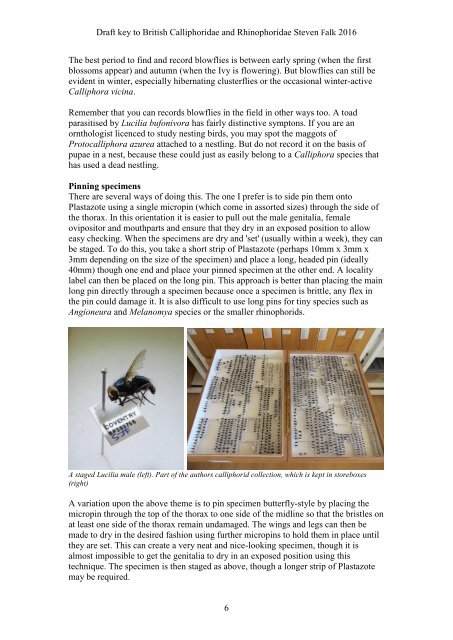BRITISH BLOWFLIES (CALLIPHORIDAE) AND WOODLOUSE FLIES (RHINOPHORIDAE)
4cmTmdCuA
4cmTmdCuA
Create successful ePaper yourself
Turn your PDF publications into a flip-book with our unique Google optimized e-Paper software.
Draft key to British Calliphoridae and Rhinophoridae Steven Falk 2016<br />
The best period to find and record blowflies is between early spring (when the first<br />
blossoms appear) and autumn (when the Ivy is flowering). But blowflies can still be<br />
evident in winter, especially hibernating clusterflies or the occasional winter-active<br />
Calliphora vicina.<br />
Remember that you can records blowflies in the field in other ways too. A toad<br />
parasitised by Lucilia bufonivora has fairly distinctive symptons. If you are an<br />
ornthologist licenced to study nesting birds, you may spot the maggots of<br />
Protocalliphora azurea attached to a nestling. But do not record it on the basis of<br />
pupae in a nest, because these could just as easily belong to a Calliphora species that<br />
has used a dead nestling.<br />
Pinning specimens<br />
There are several ways of doing this. The one I prefer is to side pin them onto<br />
Plastazote using a single micropin (which come in assorted sizes) through the side of<br />
the thorax. In this orientation it is easier to pull out the male genitalia, female<br />
ovipositor and mouthparts and ensure that they dry in an exposed position to allow<br />
easy checking. When the specimens are dry and 'set' (usually within a week), they can<br />
be staged. To do this, you take a short strip of Plastazote (perhaps 10mm x 3mm x<br />
3mm depending on the size of the specimen) and place a long, headed pin (ideally<br />
40mm) though one end and place your pinned specimen at the other end. A locality<br />
label can then be placed on the long pin. This approach is better than placing the main<br />
long pin directly through a specimen because once a specimen is brittle, any flex in<br />
the pin could damage it. It is also difficult to use long pins for tiny species such as<br />
Angioneura and Melanomya species or the smaller rhinophorids.<br />
A staged Lucilia male (left). Part of the authors calliphorid collection, which is kept in storeboxes<br />
(right)<br />
A variation upon the above theme is to pin specimen butterfly-style by placing the<br />
micropin through the top of the thorax to one side of the midline so that the bristles on<br />
at least one side of the thorax remain undamaged. The wings and legs can then be<br />
made to dry in the desired fashion using further micropins to hold them in place until<br />
they are set. This can create a very neat and nice-looking specimen, though it is<br />
almost impossible to get the genitalia to dry in an exposed position using this<br />
technique. The specimen is then staged as above, though a longer strip of Plastazote<br />
may be required.<br />
6


